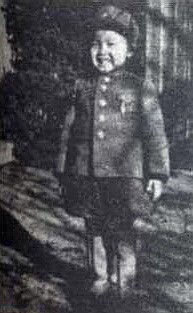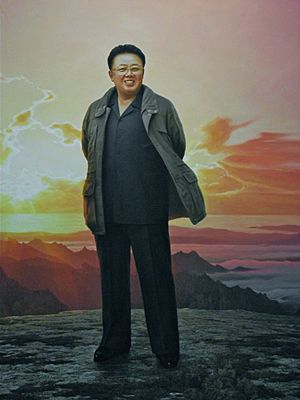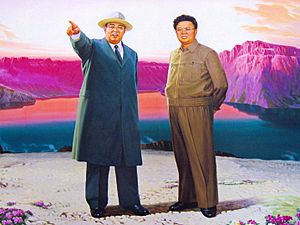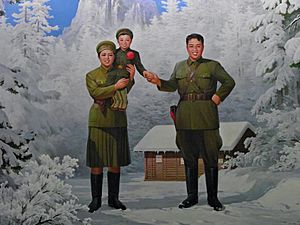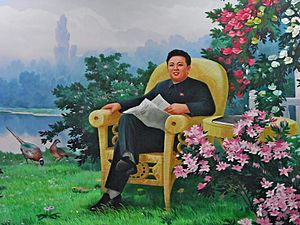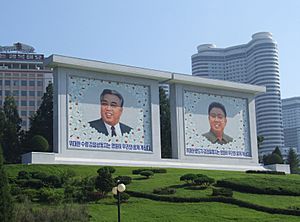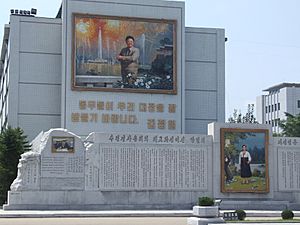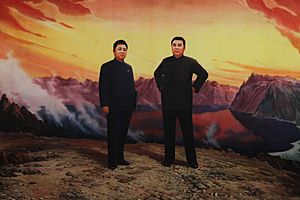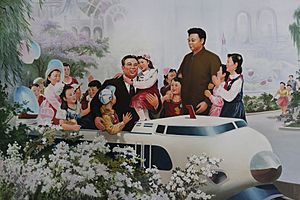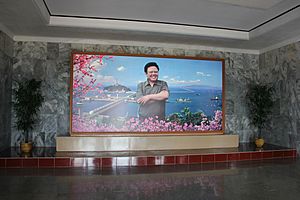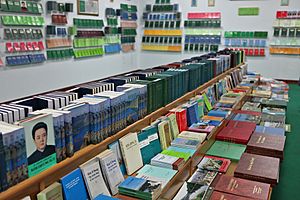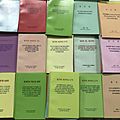Kim Jong-il facts for kids
Quick facts for kids
Kim Jong-il
|
|
|---|---|

Kim Jong-il on 24 August 2011
|
|
| Eternal General Secretary of the Workers' Party of Korea (Appellation) | |
| Assumed office 11 April 2012 |
|
| Supreme Leader of North Korea | |
| In office 8 July 1994 – 17 December 2011 |
|
| Premier | Hong Song-nam Pak Pong-ju Kim Yong-il Choe Yong-rim |
| Preceded by | Kim Il-sung (as President) |
| Succeeded by | Kim Jong-un |
| General Secretary of the Workers' Party of Korea | |
| In office 8 October 1997 – 17 December 2011 |
|
| Deputy | Kim Yong-nam Choe Yong-rim Jo Myong-rok Ri Yong-ho |
| Preceded by | Kim Il-sung |
| Succeeded by | Position abolished (Proclaimed Eternal Party General Secretary after his death) |
| Chairman of the National Defence Commission of North Korea | |
| In office 9 April 1993 – 17 December 2011 |
|
| Deputy | Jo Myong-rok |
| Preceded by | Kim Il-sung |
| Succeeded by | Position abolished as Kim Jong-il was declared as the Eternal Chairman on 13 April 2012 |
| Supreme Commander of the Korean People's Army | |
| In office 24 December 1991 – 17 December 2011 |
|
| Preceded by | Kim Il-sung |
| Succeeded by | Kim Jong-un |
| Chairman of the Central Military Commission of the Workers' Party | |
| In office 8 October 1997 – 17 December 2011 |
|
| Deputy | Kim Jong-un Ri Yong-ho |
| Preceded by | Kim Il-sung |
| Succeeded by | Kim Jong-un |
| First Vice Chairman of the National Defence Commission of North Korea | |
| In office 24 May 1990 – 9 April 1993 |
|
| Leader | Kim Il-sung |
| Preceded by | Position created |
| Succeeded by | O Chin-u |
| Personal details | |
| Born | 16 February 1941 Vyatskoye, Russian SFSR, Soviet Union (Soviet records) 16 February 1942 Baekdu Mountain, Japanese Korea (North Korean biography) |
| Died | 17 December 2011 (aged 70) Pyongyang, Democratic People's Republic of Korea |
| Resting place | Kumsusan Palace of the Sun, Pyongyang, Democratic People's Republic of Korea |
| Political party | Workers' Party of Korea |
| Spouse | Kim Young-sook (1974–2011) |
| Domestic partners | Song Hye-rim (1968–2002) Ko Young-hee (1977–2004) Kim Ok (2004–2011) |
| Children | Kim Sul-song Kim Jong-nam Kim Jong-chul Kim Jong-un Kim Yo-jong |
| Alma mater | Mangyongdae Revolutionary School Kim Il-sung University |
| Signature | |
| Military service | |
| Allegiance | |
| Branch/service | Korean People's Army |
| Years of service | 1991–2011 |
| Rank | Taewonsu (roughly translated as Grand Marshal or Generalissimo) |
| Commands | Supreme Commander |
Kim Jong-il (16 February 1941 – 17 December 2011) was the second leader of North Korea. He ruled from the death of his father Kim Il-sung, the first leader of North Korea, in 1994 until his own death in 2011. He was an unelected dictator and was often accused of human rights violations.
Kim was born in Vyatskoye, Russia, then part of the Soviet Union. By the early 1980s, Kim had become the heir apparent for the leadership of the Democratic People's Republic of Korea (DPRK) and assumed important posts in the party and army. Kim succeeded his father and DPRK founder, Kim Il-sung, following the elder Kim's death in 1994.
Kim was the General Secretary of the Workers' Party of Korea (WPK), WPK Presidium, Chairman of the National Defence Commission (NDC) of North Korea and the Supreme Commander of the Korean People's Army (KPA), the fourth-largest standing army in the world.
During Kim's rule, the country suffered famine and had a poor human rights record. Kim involved his country in state terrorism and strengthened the role of the military by his Songun ("military-first") politics. Kim's rule also saw tentative economic reforms, including the opening of the Kaesong Industrial Park in 2003. In April 2009, North Korea's constitution was amended to refer to him and his successors as the "supreme leader of the DPRK". The most common title given to Kim was "Dear Leader" to distinguish him from his father Kim Il-sung, the "Great Leader".
Following Kim's failure to appear at important public events in 2008, foreign observers assumed that Kim had either fallen seriously ill or died. On 19 December 2011, the North Korean government announced that he had died two days earlier, whereupon his third son, Kim Jong-un, was promoted to a senior position in the ruling WPK and succeeded him. After his death, Kim was designated the "Eternal General Secretary" of the WPK and the "Eternal Chairman of the National Defence Commission", in keeping with the tradition of establishing eternal posts for the dead members of the Kim dynasty.
Contents
Early life
Soviet records show that Kim was born Yuri Irsenovich Kim in 1941 in the village of Vyatskoye, near Khabarovsk, where his father, Kim Il-sung, commanded the 1st Battalion of the Soviet 88th Brigade, made up of Chinese and Korean exiles. Kim Jong-il's mother, Kim Jong-suk, was Kim Il-sung's first wife. Inside his family, he was nicknamed "Yura", while his younger brother Kim Man-il (born Alexander Irsenovich Kim) was nicknamed "Shura".
In 1945, Kim was four years old when World War II ended and Korea regained independence from Japan. His father returned to Pyongyang that September, and in late November Kim returned to Korea via a Soviet ship, landing at Sonbong. The family moved into a former Japanese officer's mansion in Pyongyang, with a garden and pool. Kim Jong-il's brother drowned there in 1948. Reports indicate that his mother died in 1949.
Education
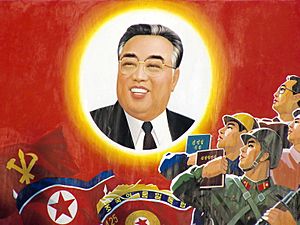
According to his official biography, Kim completed the course of general education between September 1950 and August 1960. He attended Primary School No. 4 and Middle School No. 1 (Namsan Higher Middle School) in Pyongyang.
Throughout his schooling, Kim was involved in politics. He was active in the Korean Children's Union and the Democratic Youth League of North Korea (DYL), taking part in study groups of Marxist political theory and other literature. In September 1957 he became vice-chairman of his middle school's DYL branch. He attempted to encourage greater ideological education among his classmates. Kim is also said to have received English language education in Malta in the early 1970s.
His father had meanwhile remarried and had another son, Kim Pyong-il. Since 1988, Kim Pyong-il has served in a series of North Korean embassies in Europe and was the North Korean ambassador to Poland. Foreign commentators suspect that Kim Pyong-il was sent to these distant posts by his father in order to avoid a power struggle between his two sons.
Leader of North Korea
On 8 July 1994, Kim il-sung died at the age of 82 from a heart attack. Although Kim Jong-il had been his father's designated successor as early as 1974 and had been named commander-in-chief in 1991, it took him some time to consolidate his power.
He officially took over his father's old post as General Secretary of the Workers' Party of Korea on 8 October 1997. In 1998, he was reelected as chairman of the National Defence Commission, and a constitutional amendment declared that post to be "the highest post of the state." Also in 1998, the Supreme People's Assembly wrote the president's post out of the constitution and designated Kim Il-sung as the country's "Eternal President" in order to honor his memory forever.
Officially, Kim was part of a group of three heading the executive branch of the North Korean government along with Premier Choe Yong-rim and parliament chairman Kim Yong-nam (no relation). Kim Jong-il commanded the armed forces, Choe Yong-rim headed the government and handled domestic affairs and Kim Yong-nam handled foreign relations. However, in practice Kim Jong-il exercised absolute control over the government and the country.
Kim Jong-il had a reputation for being unprofessional in matters of economic management. The economy of North Korea struggled throughout the 1990s, primarily due to mismanagement. In addition, North Korea experienced severe floods in the mid-1990s, bought on by poor land management. This with the fact that only 18% of North Korea is suitable for growing crops and the country's inability to import the goods necessary to sustain industry, led to a severe famine and left North Korea economically devastated. Faced with a country in decay, Kim adopted a "Military-First" policy to strengthen the country and reinforce the regime.
According to a 2004 Human Rights Watch report, the North Korean government under Kim was "among the world's most repressive governments", having up to 200,000 political prisoners according to U.S. and South Korean officials, with no freedom of the press or religion, political opposition or equal education: "Virtually every aspect of political, social, and economic life is controlled by the government." Kim's government was accused of "crimes against humanity" for its alleged responsibility in creating and prolonging the 1990s famine.
Foreign relations
Kim was known as a skilled and manipulative diplomat. In 1998, South Korean President Kim Dae-jung implemented the "Sunshine Policy" to improve North-South relations and to allow South Korean companies to start projects in the North. Kim Jong-il announced plans to import and develop new technologies to develop North Korea's software industry. As a result of the new policy, the Kaesong Industrial Park was constructed in 2003 just north of the de-militarized zone.
In 1994, North Korea and the United States signed an Agreed Framework which was designed to freeze and eventually dismantle the North's nuclear weapons program in exchange for aid in producing two power-generating nuclear reactors and the assurance that it won't be invaded again. In 2000, after a meeting with Madeleine Albright, he agreed to a suspension on missile construction.
In 2002, Kim Jong-il's government admitted to having produced nuclear weapons since the 1994 agreement. Kim's regime argued the secret production was necessary for security purposes, citing the presence of United States-owned nuclear weapons in South Korea and the new tensions with the United States under President George W. Bush. On 9 October 2006, North Korea's Korean Central News Agency announced that it had successfully conducted an underground nuclear test.
Cult of personality
Kim Jong-il was the focus of an elaborate personality cult inherited from his father and founder of the DPRK, Kim Il-sung. Kim Jong-il was often the centre of attention throughout ordinary life in the DPRK. On his 60th birthday, mass celebrations occurred throughout the country on the occasion of his Hwangap. In 2010, the North Korean media reported that Kim's distinctive clothing had set worldwide fashion trends.
The prevailing point of view is that the people's adherence to Kim Jong-il's cult of personality was solely out of respect for Kim Il-sung or out of fear of punishment for failure to pay homage. Media and government sources from outside North Korea generally support this view, while North Korean government sources aver that it was genuine hero worship. The song "No Motherland Without You", sung by the KPA State Merited Choir, was created especially for Kim in 1992 and is frequently broadcast on the radio and from loudspeakers on the streets of Pyongyang.
Personal life
There is no official information available about Kim Jong-il's marital history, but he is believed to have been officially married twice. He had three known sons: Kim Jong-nam, Kim Jong-chul and Kim Jong-un. His two known daughters are Kim Sul-song and Kim Yo-jong. He had a younger sister, Kim Kyong-hui.
Like his father, Kim had a fear of flying and always travelled by private armored train for state visits to Russia and China. Kim was said to be a huge film fan, owning a collection of more than 20,000 video tapes and DVDs. His reported favourite movie franchises included James Bond, Rambo, Godzilla and Hong Kong action cinema, with Sean Connery and Elizabeth Taylor his favourite male and female actors.
In a 2011 news story it was reported "Kim Jong-il was obsessed with Elvis Presley. His mansion was crammed with his idol's records and his collection of 20,000 Hollywood movies included Presley's titles. He even copied the Presley's Vegas-era look of giant shades, jumpsuits and hairstyle.
Although Kim enjoyed many foreign forms of entertainment, according to former bodyguard Lee Young Kuk, he refused to consume any food or drink not produced in North Korea, with the exception of wine from France. His former chef Kenji Fujimoto, however, has stated that Kim sometimes sent him around the world to purchase a variety of foreign delicacies.
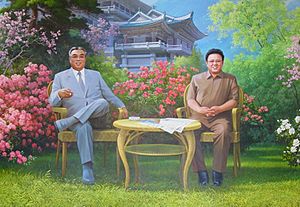
Kim reportedly enjoyed basketball. Former United States Secretary of State Madeleine Albright ended her summit with Kim by presenting him with a basketball signed by NBA legend Michael Jordan. His official biography also claims that Kim composed six operas and enjoys staging elaborate musicals.
United States Special Envoy for the Korean Peace Talks, Charles Kartman, who was involved in the 2000 Madeleine Albright summit with Kim, characterised Kim as a reasonable man in negotiations, to the point, but with a sense of humor and personally attentive to the people he was hosting.
Defectors claimed that Kim had 17 different palaces and residences all over North Korea, including a private resort near Baekdu Mountain, a seaside lodge in the city of Wonsan, and Ryongsong Residence, a palace complex northeast of Pyongyang surrounded with multiple fence lines, bunkers and anti-aircraft batteries.
According to the Sunday Telegraph, Kim had US$4 billion on deposit in European banks in case he ever needed to flee North Korea. The Sunday Telegraph reported that most of the money was in banks in Luxembourg.
Death
It was reported that Kim Jong-il had died of a suspected heart attack on 17 December 2011 at 8:30 a.m while travelling by train to an area outside Pyongyang. He was succeeded by his youngest son Kim Jong-un, who was hailed by the Korean Central News Agency as the "Great Successor".
Kim Jong-il's funeral took place on 28 December in Pyongyang, with a mourning period lasting until the following day. South Korea's military was immediately put on alert after the announcement and its National Security Council convened for an emergency meeting, out of concern that a attempt to get power in North Korea could destabilise the region. Asian stock markets fell soon after the announcement, due to similar concerns.
On 12 January 2012, North Korea called Kim Jong-il the "eternal leader" and announced that his body would be preserved and displayed at Pyongyang's Kumsusan Memorial Palace. Officials also announced plans to install statues, portraits, and "towers to his immortality" across the country. His birthday of 16 February was declared "the greatest holiday of the nation" and was named the Day of the Shining Star.
In February 2012, on what would have been his 71st birthday, Kim Jong-il was posthumously made Dae Wonsu, literally Grand Marshal), the nation's top military rank. He had been named Wonsu (Marshal) in 1992 when North Korean founder Kim Il-sung was promoted to Dae Wonsu.
Also in February 2012, the North Korean government created the Order of Kim Jong-il in his honor and awarded it to 132 individuals for services in building a "thriving socialist nation" and for increasing defense capabilities.
Official titles
- Party Center of the WPK and Member, Central Committee of the WPK (1970s)
- Dear Leader (Chinaehaneun Jidoja) (late 1970s–1994)
- Member Presidium of the Supreme People's Assembly of the DPRK
- Secretary Central Committee of the Workers' Party of Korea (1974–1997)
- Presidium member, WPK Central Committee (1980–2011)
- Supreme Commander Korean People's Army (25 Dec 1991 – 17 Dec 2011)
- Marshal of the DPRK (1993–2011)
- Chairman, National Defence Commission (1993–2011)
- Great Leader (Widehan Ryongdoja) (July 1994 – December 2011)
- General Secretary Workers' Party of Korea (October 1997 – December 2011)
- Chairman Central Military Commission (DPRK) (October 1997 – December 2011)
- Eternal Leader (posthumous) (January 2012 – present)
- Generalissimo of the DPRK (posthumous) (January 2012 – present)
- Eternal General Secretary Workers' Party of Korea (11 April 2012 – present)
- Eternal Chairman of the National Defence Commission (13 April 2012 – present)
- Eternal leader of the Workers' Party of Korea (posthumous) (7 May 2016 – present)
- Eternal leader of the Democratic People's Republic of Korea (29 June 2016 – present)
According to North Korean sources, Kim Jong-il published some 890 works during a period of his career from June 1964 to June 1994. According to KCNA, the number of works from 1964 to 2001 was 550. In 2000, it was reported that the Workers' Party of Korea Publishing House has published at least 120 works by Kim. In 2009, KCNA put the number of his books at 354,000 copies, which were translated into nearly 70 languages and came off the press in about 80 countries.
The Selected Works of Kim Jong-il, publishing has continued and runs into volume 24. The Complete Collection of Kim Jong-il's Works is currently in volume 13. There is a "Kim Jong-il's Works Exhibition House" dedicated to his works in North Korea, holding 1,100 of his works and manuscripts.
In his teens and university years, Kim Jong-il wrote poems – notably "O Korea, I will Add Glory to Thee". Kim Jong-il also wrote song lyrics. His first major literary work was On the Art of the Cinema in 1973.
Images for kids
-
Kim talking with Russian President Vladimir Putin during their 2001 meeting in Moscow
-
Kim Ok, Kim's personal secretary, with U.S. Secretary of Defense William Cohen, 2000
See also
 In Spanish: Kim Jong-il para niños
In Spanish: Kim Jong-il para niños


